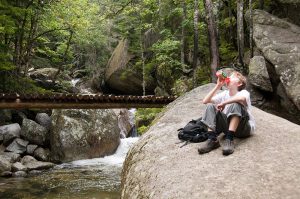Bulletin #4279, Food Safety for Camping and Hiking
Food Safety Facts
By Mahmoud El-Begearmi, Extension professor, nutrition and food safety, University of Maine Cooperative Extension (Original title: Food Safety for Outdoor Enthusiasts).
Revised by Jason Bolton, associate Extension professor and food safety specialist, University of Maine Cooperative Extension.
Reviewed and revised by Beth Calder, Extension Food Science Specialist, University of Maine Cooperative Extension.
For information about UMaine Extension programs and resources, visit extension.umaine.edu.
Find more of our publications and books at extension.umaine.edu/publications/.
Camping and hiking are wonderful ways to experience the great outdoors and the beauty of nature. But getting sick from foodborne illness can really put a damper on your trip. Symptoms of foodborne illness can be mild, like an upset stomach. Or they can be serious, requiring an urgent visit to the hospital. The following information can help you avoid foodborne illness.
Pack Perishable Food Safely
- Use a cooler with plenty of ice packs to keep perishable foods below 40°F.
- Bacteria grow rapidly when food is held between 40°F and 140°F. This is referred to as the danger zone. Foods that need refrigeration or heating should not be held in the danger zone for more than two hours.
- Pack frozen foods and beverages in your cooler, in addition to cold packs. They can help keep the cooler cold enough.
- Make sure that raw meat and poultry are well wrapped and thoroughly sealed.
- Raw meat and poultry that aren’t well packaged can drip liquids that spoil other foods.
- Do not eat leftovers unless they have been kept cold.
Keep Clean
- The same food-safety rules apply to outdoor cooking as home cooking.
- Properly wash your hands before and after handling food. This is the first line of food-safety defense.
- Hand sanitizing gel, foam, or wipes can be used for quick sanitation, but these products are not designed to remove dirt and debris. For dirt or debris, use soap and water.
- Bring biodegradable soap for hand- and dish-washing.
Cook Thoroughly
There are dangers in preparing meats. Many types of meat can carry disease-causing bacteria. It is important to cook meat thoroughly to kill these bacteria. For example, chicken can be contaminated with Salmonella, which can cause foodborne illness. Cook meat until it reaches a safe temperature. The best way to ensure this is to bring a meat thermometer.
| Food | Internal Temperature |
|---|---|
| Beef, veal, and lamb steaks and roasts | 145°F |
| Fish | 145°F |
| Pork (cuts) | 145°F |
| Ground Meat (beef, veal, pork, sausages, and lamb) | 160°F |
| Egg dishes | 160°F |
| Chicken, turkey, duck (whole, pieces, and ground) | 165°F |
Make Your Water Safe
- Do not drink water from rivers, lakes, ponds, or streams.
- Bring fresh drinking water with you. Replenish your water whenever water from a known public system is available.
- If a known potable/sanitary water source is not available, there are several ways to make fresh water safer to drink. These include boiling, purification tablets, and filtration. If you use boiling or purification tablets to disinfect water, you must remove the sediment from the water first. You can do this by allowing the sediment to settle, then pouring off the clear water to disinfect. Depending upon the sediment, it can take between 10 and 30 minutes for sediment to settle. Wait until the water looks clear.
- Boiling: Bring the water to a rolling boil for one minute. Note: The Centers for Disease Control recommends that at elevations above 6,500 feet, the water must be boiled for at least three minutes.
- Purification tablets: When added to water these will kill most bacteria, viruses, and parasites but not all. For instance they will not kill Cryptosporidium parvum, Giardia lamblia (“beaver fever”), and larger bacteria. You can buy these tablets at most sporting goods-stores.
- Filtration: Choose a filter that removes bacteria and protozoa, including Giardia and Cryptosporidium.
Pack Nonperishable Foods
The following foods have a long shelf life and withstand temperature extremes. They are ideal foods for camping and hiking.
- Peanut butter
- Canned meats — tuna, chicken, ham, beef, turkey
- Condensed and boxed soups
- Canned baked beans
- Dried foods — fruit, beef, turkey, beans
- Nuts
- Powered mixes — milk, instant breakfast, eggs, pancakes
- Pasta
- Oatmeal
- Dehydrated and/or freeze-dried meals
- Tap or bottled water
For more camping and hiking food-safety tips, see the USDA Safe Food Handling Fact Sheet, “Food Safety While Hiking, Camping & Boating.”
Information in this publication is provided purely for educational purposes. No responsibility is assumed for any problems associated with the use of products or services mentioned. No endorsement of products or companies is intended, nor is criticism of unnamed products or companies implied.
© 2004, 2011, 2022
Call 800.287.0274 (in Maine), or 207.581.3188, for information on publications and program offerings from University of Maine Cooperative Extension, or visit extension.umaine.edu.
The University of Maine is an EEO/AA employer, and does not discriminate on the grounds of race, color, religion, sex, sexual orientation, transgender status, gender expression, national origin, citizenship status, age, disability, genetic information or veteran’s status in employment, education, and all other programs and activities. The following person has been designated to handle inquiries regarding non-discrimination policies: Director of Equal Opportunity, 101 Boudreau Hall, University of Maine, Orono, ME 04469-5754, 207.581.1226, TTY 711 (Maine Relay System).


